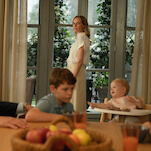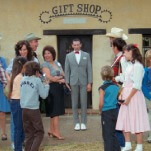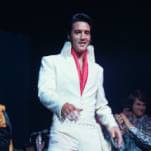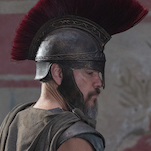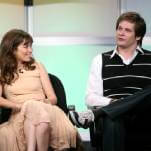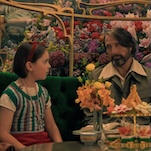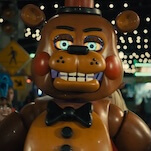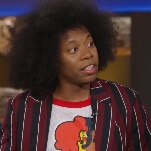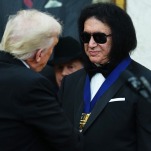Mary Hartman, Mary Hartman combined soap opera, satire, and nightmare
For most of the history of television, the barrier to syndication—and to profitability—has been 100 episodes. The shows that have made it to that mark are an unusual group. Many were big hits. Some found small cult audiences. Still others just hung on as best they could and never posted numbers quite low enough to be canceled. In 100 Episodes, we examine shows that made it to that number, considering both how they advanced or reflected the medium and what contributed to their popularity.
When viewers first see Louise Lasser’s dissatisfied housewife, Mary Hartman, she’s grappling with more than her white whale, the waxy yellow buildup on her linoleum kitchen floor. She’s also caught up in a soap opera. “What could we possibly be to each other, with you in jail and me on crutches?” asks an unseen drama queen on the TV within the TV. As The New York Times said in a 2000 retrospective of the series, Mary Hartman, Mary Hartman “was postmodern before postmodern had a name.” Mary’s sister Cathy (Debralee Scott) shrugs with her eyebrows, but Mary needs a moment to absorb the full profundity of her story. “That Joan, she is so wonderful no matter what happens to her,” she says. Sirens start wailing on that unsettling phrase. “No matter what happens to her.” It isn’t just Joan’s grace Mary admires, but her capacity for trauma, too. As quickly as the thought leaves Mary’s head, she’s moved on to beaming about her new floor polish. Cathy’s not impressed, pointing out the waxy yellow buildup. Mary can’t believe it. The ads say that’s impossible.
Traditionally, Mary Hartman, Mary Hartman is described as a soap-opera parody. Producer Norman Lear is fond of saying that some people watched the series for the stories, propelled by dramatic excitement, and others watch for the comedy, all straight-faced exaggeration. The idea was to serve both audiences, and in so doing, the writers trap Mary in the tension between the soap and the satire, between the life she’s been sold and a greater awareness. In that opening scene, what’s obvious to Cathy is something that Mary can barely discern. A nightmarish close-up shows Mary staring directly into the camera, into domestic spaces across America, searching for signs of gunk on society. “It is a little yellow, isn’t it?”
The month Mary Hartman, Mary Hartman debuted, Time magazine named its annual Person Of The Year for 1975. Or in this case, Persons Of The Year: American women. “They have arrived like a new immigrant wave in male America,” reads the cover story. “They may be cops, judges, military officers, telephone linemen, cab drivers, pipefitters, editors, business executives—or mothers and housewives, but not quite the same subordinate creatures they were before.” It was January 1976, the year of Jeanne Dielman and Carrie White. Women’s lib enjoyed majority support according to polls. That year The ABC Evening News would hire America’s first female national news co-anchor in Barbara Walters. Television super-producer Lear dominated the Nielsen ratings—his All In The Family and Sanford And Son topped them for the 1974-75 season—but his shows had few female voices behind the camera. That is, until he clicked with the two writers and director who shepherded his next concept: Gail Parent, Ann Marcus, and Joan Darling.
The skeleton of Mary Hartman came to Lear in the late ’60s when he decided to do a comic soap opera, but it took comedy writer Gail Parent to lay a foundation for the show. Together they established Mary Hartman, Mary Hartman as a daily blue-collar soap in opposition to the typical upper-crust daytime milieu: Protagonist Mary is an average suburban housewife in a dysfunctional relationship with an auto worker. Lear also had particular ideas about what would happen in the first week: The show would open with the mass murder of a neighborhood family along with their goats and chickens; the town flasher would turn out to be Mary’s grandfather; and when Mary and her husband Tom finally get to bed, Tom would face erectile dysfunction. These obstacles stymied the writers brought in to flesh out Parent’s basis into a pilot. But then Lear met Ann Marcus.
Ann Marcus has a way with words and feminism, branding herself “the first copy boy with a D-cup” back when she worked in newsrooms. She spent the ’60s climbing the ladder from writing sitcom scripts (The Hathaways, Please Don’t Eat The Daisies), to staff- and eventually head-writer positions on soaps (Peyton Place, Love Is A Many-Splendored Thing) where she worked to address topical issues like racism and Vietnam. For Mary Hartman, she turned to her co-writers on Love, Jerry Adelman and Daniel Gregory Browne (then going by his birth name, Ken Hartman). With Marcus as head writer, they wrote a 60-page series bible for six months’ worth of story, and then they wrote scripts for the first two weeks. Marcus changed the Fernwood Flasher to Mary’s 83-year-old grandfather, and Browne came up with the waxy yellow buildup. For Mary, they chose Louise Lasser, a smart, twangy goof from Woody Allen’s early films. Based on those scripts, CBS head of programming Fred Silverman put up $100,000 for two pilot episodes, the first of which would win Marcus, Browne, and Adelman an Emmy.
Meanwhile, actress Joan Darling met with Lear to discuss a Golda Meir biopic she hoped to star in, but Lear had another idea in mind. “Joan, how would you like to be a director?” The idea of a woman directing American TV was so foreign that Darling needed a minute. Taking after Elaine May and Meta Rosenberg—a directing producer on The Rockford Files—Darling agreed as long as she could have a personal stake in the content. So, after assembling a cast led by Lasser, Darling directed the two pilots as a stage production, and Lear hired someone else to film it. Afterward he convinced Darling to shoot it herself, and then to cut it together, too.
Darling’s pilot sets the stage for the show to come: Heavy-handed organs comment on the action, extravagant act-break pauses make time for irises out, and there’s no studio-audience laughter breaking the illusion that Fernwood, Ohio, is the setting of a straightforward soap opera. The formal jokes, however, didn’t match the drama onstage. Lear recalls the connection between star Lasser and director Darling, saying whatever he expected from his comic soap, he could never have conceived of Lasser’s performance or Darling’s ability to bring it out of her. Executives swooned over the finished product, but had no intention of actually airing it. According to Darling, Silverman called it “the best-directed, best-acted, best-written show he’d seen, and it would never in a million years see the light of day as a television show.” So Darling started using the Mary Hartman pilot as her reel, which led to her first assignment that actually aired: The Mary Tyler Moore Show’s “Chuckles Bites The Dust,” the sitcom episode TV Guide would deem the best ever.
As for Mary Hartman, Lear was rejected by all three major networks, but that only created more buzz. So he invited local station owners to a dinner and a screening at his Brentwood home, hoping to sell the show into first-run syndication. He next took to the road, traveling the country to sell Mary Hartman personally to individual television stations. It went for irresistibly cheap rates—Lear lost $1.2 million on the first season—but Mary Hartman was on the air. By the time of the premiere, the producer had assembled at least 54 stations to carry Mary, usually after the late-night news. Two months later he had 70, and by the end of the season he was up to 100.

























